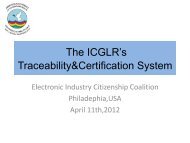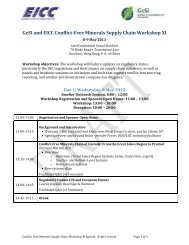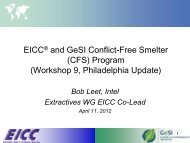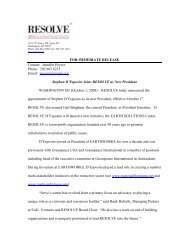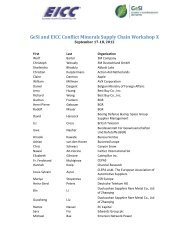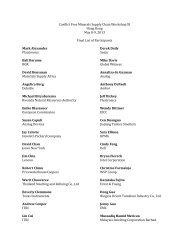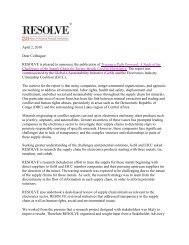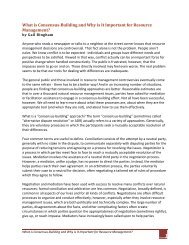Toward SuSTainabiliTy: The roleS and limiTaTionS of ... - Resolve
Toward SuSTainabiliTy: The roleS and limiTaTionS of ... - Resolve
Toward SuSTainabiliTy: The roleS and limiTaTionS of ... - Resolve
You also want an ePaper? Increase the reach of your titles
YUMPU automatically turns print PDFs into web optimized ePapers that Google loves.
Chapter 2: Actors – Government 38Other institutional structures consistent withdemocratic principles include documented rulemakingprocesses requiring meaningful responsesto criticism, structured adjudication by experts,<strong>and</strong> transparency (see for example Meidinger,2006). <strong>The</strong>se systems seem to be stimulatingengagement in policy <strong>and</strong> practices from a widerrange <strong>of</strong> community participants than had previouslyparticipated in many locations. For example,a wider range <strong>of</strong> stakeholders are engaged inforest policy in Estonia, Latvia, <strong>and</strong> Russia due inlarge part to the increase in forest certification inthose countries. Potentially, certification may becontributing to new models for how policy shouldbe made (Cashore, et al., 2006).Meidinger (2006) notes that, in many places,forest policy traditionally was limited to governmentagencies working in close relationships withthe forest industry, foresters, <strong>and</strong> l<strong>and</strong>owners.Policies reflected the needs <strong>and</strong> desires <strong>of</strong> thoseinterests, not others. Regulatory <strong>and</strong> legal challengeshad limited success. <strong>The</strong> FSC openedup that closed system by creating a parallelregulatory program <strong>and</strong> threatening the br<strong>and</strong>s<strong>of</strong> companies that depend on global markets(Meidinger, 2006). Such public participation <strong>and</strong>transparency requirements are now a part <strong>of</strong> theISEAL St<strong>and</strong>ard-Setting Code <strong>of</strong> Good Practice forst<strong>and</strong>ards <strong>and</strong> certification schemes, reflectingthe practice <strong>of</strong> greater public participation in othersectors as well.By contrast, V<strong>and</strong>ergeest (2007) maintains thatthe transnational certification <strong>of</strong> shrimp farmingleaves local communities out <strong>of</strong> basic decisionmaking regarding resource management, suchas setting st<strong>and</strong>ards <strong>and</strong> certifying producers. Inthat respect, certification schemes can be lessdemocratic than community-based managementapproaches aligned with local governance structures.In southern Thail<strong>and</strong>, community-basedapproaches to shrimp farm management havedeveloped in response to national <strong>and</strong> provinciallaws allowing local zoning <strong>and</strong> decision makingthough village administrative units. Examiningthe regulation <strong>of</strong> shrimp farming in several districtsin southern Thail<strong>and</strong>, V<strong>and</strong>ergeest foundthat regulations varied, but <strong>of</strong>ten were tied tolocal ecological <strong>and</strong> social contexts, which meantdifferent environmental problems <strong>and</strong> hencedifferent solutions. In contrast, all <strong>of</strong> the transnationalcertification schemes for shrimp farming(including those <strong>of</strong> the Aquaculture CertificationCouncil, EurepG.A.P., the U.K. Soil Association,Naturl<strong>and</strong>, <strong>and</strong> others) had immutable technicalst<strong>and</strong>ards developed separately from communities,essentially by an overlapping network <strong>of</strong>international technical experts. <strong>The</strong> technicalenvironmental st<strong>and</strong>ards <strong>of</strong> these schemes wereentirely distinct from their “social” st<strong>and</strong>ards,which were established to respect local laws,protect worker rights, <strong>and</strong> assure local access topublic resources. Despite the presence <strong>of</strong> socialst<strong>and</strong>ards, the technical st<strong>and</strong>ards for practicessuch as siting <strong>and</strong> waste management did notinvolve local communities in formulating locallyspecific guidelines, monitoring, or enforcement.To many Southern NGOs, this lack <strong>of</strong> meaningfulinput into technical st<strong>and</strong>ards <strong>and</strong> decisionmaking is a major criticism <strong>of</strong> transnational certificationschemes, <strong>and</strong> a basis for their opposition(V<strong>and</strong>ergeest, 2007).Transparency, public participation, <strong>and</strong> effectiveadjudication are important democratic principlesthat may be applied, or enhanced, through acredible certification scheme. But the overarchingissue <strong>of</strong> how certification schemes are heldaccountable, <strong>and</strong> to whom, goes beyond theseprocedural requirements. Traditionally, accountabilitymay have implied a clear hierarchy withlegitimate decision makers at each level whoseconcerns must be addressed. But voluntary certificationsystems by their nature reflect a morenetworked approach to problem solving <strong>and</strong>accountability. Accountability should be consideredat multiple levels, perhaps the most obviousbeing at the level <strong>of</strong> the certifiers who audit theperformance <strong>of</strong> firms claiming to meet a st<strong>and</strong>ard.Meidinger (2006) discusses accountabilityin the forest certification realm as a “package <strong>of</strong>actors, norms, <strong>and</strong> institutions,” which cannotbe considered separately. This package includesNGOs, consumers, producers, retailers, governments,<strong>and</strong> others, which influence one anotherto develop new values <strong>and</strong> solutions over time.<strong>Toward</strong> Sustainability: <strong>The</strong> Roles <strong>and</strong> Limitations <strong>of</strong> Certification



